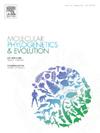Phylogenomic analyses unravel the tangled evolutionary history of Genisteae (Fabaceae)
IF 3.6
1区 生物学
Q2 BIOCHEMISTRY & MOLECULAR BIOLOGY
引用次数: 0
Abstract
Genisteae, a tribe in the subfamily Papilionoideae (Fabaceae), is characterized by the production of quinolizidine alkaloids that confer pest resistance in most of its members. Many relationships at the generic level remain unresolved due largely to a lack of modern attempts to reconstruct the phylogeny. Previous studies with limited taxon sampling and only a few molecular loci indicated the presence of three clades within the tribe: the Lupinus clade, the Cytisus-Genista complex and the Argyrolobium group. There are also two historical genera, Teline and Chamaecytisus, that have been reclassified over the years with some controversy. Species from Teline are currently classified in Genista, and Chamaecytisus species are placed inside of Cytisus. Sellocharis is another genus with vague placement inside of Genisteae near Anarthrophyllum, based mostly on morphology and cytology. Representative taxa from 24 of the 25 genera of Genisteae, along with species of historical genera Teline and Chamaecytisus, were sampled and utilized in a phylogenomic investigation using both plastid and nuclear data to resolve relationships at the generic level. Whole genomic DNA was sequenced and complete plastomes were assembled and annotated. Low-copy nuclear genes were retrieved from the genomic DNA sequences using a mapping-assembly-scaffold approach. Phylogenetic analyses using maximum likelihood, Bayesian and coalescence methods resulted in fully resolved and strongly supported trees for both nuclear and plastid data that show four major clades inside of Genisteae: Cytisus-Genista complex, Lupinus clade, Argyrolobium group and the novel Anarthrophyllum group. The resulting phylogenetic trees also supported the transfer of the Argyrolobium group from Crotalarieae to Genisteae, and the reclassification of Teline inside of Genista, both of which were previously suggested in literature. The phylogenetic trees also determined a placement for Sellocharis in the new Anarthrophyllum group. Although both nuclear and plastid trees were congruent with respect to the monophyly and relationships among the four major clades, incongruence was detected within some of the major clades and the potential causes are discussed.

系统基因组学分析揭示了金Genisteae (Fabaceae)错综复杂的进化史。
金凤花科是凤蝶亚科(豆科)中的一个分支,其特点是产生喹啉类生物碱,使其大多数成员具有抗虫性。由于缺乏重建系统发育的现代尝试,许多在一般水平上的关系仍未得到解决。以往的研究通过有限的分类单元采样和少量的分子位点表明,该部落中存在三个分支:Lupinus分支,Cytisus-Genista复合体和Argyrolobium组。历史上还有两个属,Teline和Chamaecytisus,多年来一直被重新分类,但存在一些争议。来自Teline的物种目前被分类在Genista中,Chamaecytisus物种被放在Cytisus中。Sellocharis是另一个定位模糊的属,主要基于形态学和细胞学。本文选取了金雀花科25属中24属的代表性分类群,以及历史上的Teline属和Chamaecytisus属的种,利用质体和核数据进行了系统基因组学研究,以解决属水平上的关系。测序全基因组DNA,组装完整质体并进行注释。利用定位-组装-支架方法从基因组DNA序列中检索低拷贝核基因。利用最大似然、贝叶斯和聚结方法进行系统发育分析,得到了核和质体数据的完全解析和强有力支持的树,显示了金雀亚科内部的四个主要分支:Cytisus-Genista复合体、Lupinus分支、Argyrolobium类群和新的Anarthrophyllum类群。所得到的系统发育树也支持了Argyrolobium类群从crotalariae向gensteae的转移,以及Genista内部的Teline的重新分类,这两个都是之前文献中提出的。系统发育树还确定了Sellocharis在新的节肢动物组中的位置。尽管核树和质体树在四个主要分支的单系和关系方面是一致的,但在一些主要分支中发现了不一致,并讨论了可能的原因。
本文章由计算机程序翻译,如有差异,请以英文原文为准。
求助全文
约1分钟内获得全文
求助全文
来源期刊
CiteScore
7.50
自引率
7.30%
发文量
249
审稿时长
7.5 months
期刊介绍:
Molecular Phylogenetics and Evolution is dedicated to bringing Darwin''s dream within grasp - to "have fairly true genealogical trees of each great kingdom of Nature." The journal provides a forum for molecular studies that advance our understanding of phylogeny and evolution, further the development of phylogenetically more accurate taxonomic classifications, and ultimately bring a unified classification for all the ramifying lines of life. Phylogeographic studies will be considered for publication if they offer EXCEPTIONAL theoretical or empirical advances.

 求助内容:
求助内容: 应助结果提醒方式:
应助结果提醒方式:


